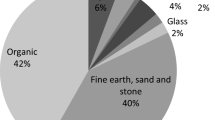Abstract
The sustainable synthesis of nanoparticles provides an eco-friendly and interesting approach in the domain of clean synthesis and nanobiotechnology. The in vitro synthesis of silver nanoparticles from the aqueous extract of an indigenous South African plant: Ekebergia capensis is reported in this paper. The rapid fabrication of Ag NPs were observed by visual colour and was confirmed using UV spectroscopy; the emergence of a yellow–brownish colour confirmed the yield of silver nanoparticles. Also, a time course study on the effect of concentration of AgNO3 was undertaken. The synthesized Ag NPs was characterized by TEM, XRD, and DLS whilst, FTIR and GC–MS provided information on the functional groups adhered to the surface of the Ag NPs. The XRD peak of synthesized Ag NPs showed their crystalline structure. DLS and TEM studies revealed spherical or near spherically shaped Ag NPs of particle size 20–120 nm. Furthermore, the catalytic performance of Ag NPs in the degradation of Allura red (AR) and Congo red (CR) were characterised by UV spectrophotometry. The Silver nanoparticles were observed to have excellent catalytic properties on the degradation of AR and CR which is confirmed by the dyes mineralized in λmax values. The catalytic process involved the electrons relay effect and is attributed with time.










Similar content being viewed by others
References
G. Sharmila, M. F. Fathima, S. Haries, S. Geetha, N. M. Kumar, and C. Muthukumaran (2017). Green synthesis, characterization and antibacterial efficacy of palladium nanoparticles synthesized using Filicium decipiens leaf extract. J. Mol. Struct. 1138, 35–40.
K. Muthu, and S. Priya (2017). Green synthesis, characterization and catalytic activity of silver nanoparticles using Cassia auriculata flower extract separated fraction. Spectrochim. Acta A. 179, 66–72.
R. Bendi, T. Imae, and A. G. Destaye (2015). Ag nanoparticle-immobilized cellulose nanofibril films for environmental conservation. Appl. Catal. A 492, 184–189.
A. Khamhaengpol, and S. Sri (2017). Green synthesis of silver nanoparticles using tissue extract of weaver ant larvae. Mater. Lett. 192, 72–75.
B. Archana, K. Manjunath, G. Nagaraju, K. B. Chandra Sekhar, and N. Kottam (2017). Enhanced photocatalytic hydrogen generation and photostability of ZnO nanoparticles obtained via green synthesis. Int. J. Hyd. Energy. 42, 5125–5131.
A. Gangadhara, R. Ramya, and R. Subashini (2014). In-vitro anti-inflammatory and mosquito larvicidal efficacy of nickel nanoparticles phytofabricated from aqueous leaf extracts of Aegle marmelos Correa. Acta Trop. 135, 19–26.
R. Gengan, K. Anand, A. Phulukdaree, and A. Chuturgoon (2013). A549 lung cell line activity of biosynthesized silver nanoparticles using Albiziaadianthifolia leaf. Colloids Surf. B 105, 87–91.
N. R. Panyala, E. M. P. Mendez, and J. Havel (2008). Silver or silver nanoparticles: a hazardous threat to the environment and human health. J. Appl. Biomed. 6, 117–129.
C. P. Devatha, A. K. Thalla, and S. Y. Katte (2016). Green synthesis of iron nanoparticles using different leaf extracts for treatment of domestic wastewater. J. Cleaner Prod. 136, 1425–1435.
J. K. Patra, Y. Kwon, and K.-H. Beek (2016). Green biosynthesis of gold nanoparticles by onion peel extract: synthesis, characterization and biological activities. Adv. Powder Technol.. doi:10.1016/j.apt.2016.08.005.
Y. Wei, Z. Fang, L. Zheng, L. Tan, and E. P. Tsang (2016). Green synthesis of Fe nanoparticles using Citrus maxima peels aqueous extracts. Mater. Lett. 186, 384–386.
Is. Fatimah (2016). Green synthesis of silver nanoparticles using extract of Parkia speciosa Hassk pods assisted by microwave irradiation. J. Adv. Res. 7, 961–969.
D. A. Kumar, V. Palanichamy, and S. M. Roopan (2014). Green synthesis of silver nanoparticles using Alternanthera dentata leaf extract at room temperature and their antimicrobial activity. Spectrochim. Acta A 127, 168–171.
Y. Li, W. Wu, P. Dai, L. Zhang, Z. Sun, and G. Li (2014). WO3 and Ag nanoparticle sensitized TiO2 nanowires: preparation and the enhancement of photocatalytic activity. RSC Adv. 4, 23831–23837.
M. S. Geetha, H. Nagabhushana, and H. N. Shivananjaiah (2016). Green mediated synthesis and characterization of ZnO nanoparticles using Euphorbia Jatropa latex as reducing agent. J. Sci. Adv. Mater. Dev. 1, 301–310.
J. L. Anyik, and O. S. Oluwafemi (2017). Plant-mediated synthesis of platinum nanoparticles using water hyacinth as an efficient biomatrix source – An eco-friendly development. Mater. Lett. 196, 141–144.
S. Pugazhendhi, P. Sathya, P. K. Palanisamy, and R. Gopalakrishnan (2016). Synthesis of silver nanoparticles through green approach using Dioscorea alata and their characterization on antibacterial activities and optical limiting behaviour. J. Photochem. Photobiol. B. 159, 155–160.
L. Fu, Y. Zheng, Q. Ren, A. Wang, and B. Deng (2015). Green biosynthesis of SnO2 nanoparticles by Plectranthus amboinicus extract leaf extract their photocatalytic activity towards Rhodamine B degradation. J. Ovonic Res. 11, 21–26.
A. Bhattacharjee and M. Ahmaruzzaman (2015). A green approach for the synthesis of SnO2 nanoparticles and its application. Mater. Lett. 157, 260–264.
R. Govender, A. Phulukdaree, R. M. Gengan, K. Anand, and A. A. Chuturgoon (2013). Silver nanoparticles of Albiziaadianthifolia: the induction of apoptosis in human lung carcinoma cell line. J. Nanobiotech. 11, 1–9.
Acknowledgements
All the authors acknowledged towards National Research Foundation (NRF) and Durban University of Technology (DUT) for funding this project, Durban, South Africa.
Author information
Authors and Affiliations
Corresponding authors
Ethics declarations
Conflict of interest
The authors confirm that there are no known conflicts of interest regarding this publication.
Electronic supplementary material
Below is the link to the electronic supplementary material.
Rights and permissions
About this article
Cite this article
Anand, K., Kaviyarasu, K., Muniyasamy, S. et al. Bio-Synthesis of Silver Nanoparticles Using Agroforestry Residue and Their Catalytic Degradation for Sustainable Waste Management. J Clust Sci 28, 2279–2291 (2017). https://doi.org/10.1007/s10876-017-1212-2
Received:
Published:
Issue Date:
DOI: https://doi.org/10.1007/s10876-017-1212-2




